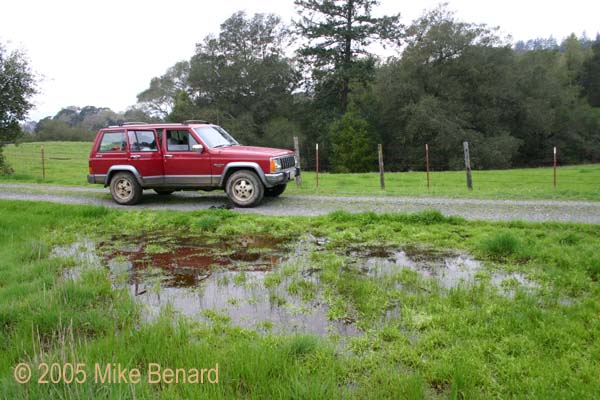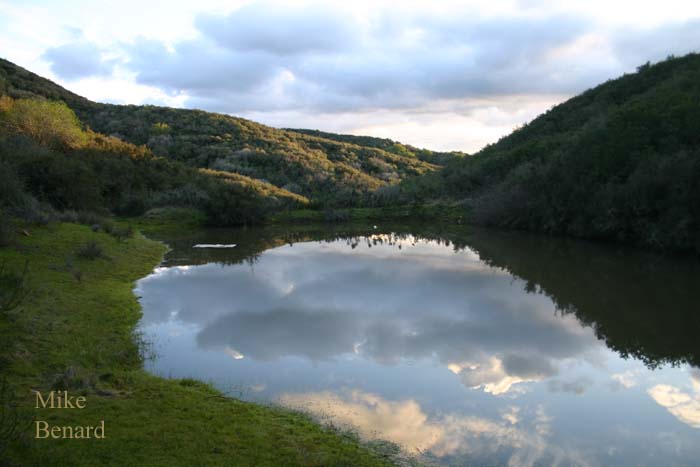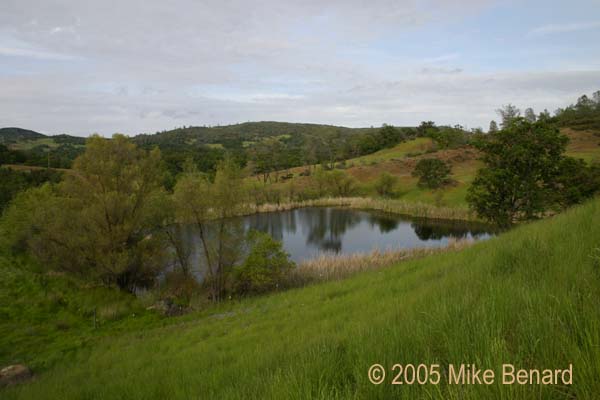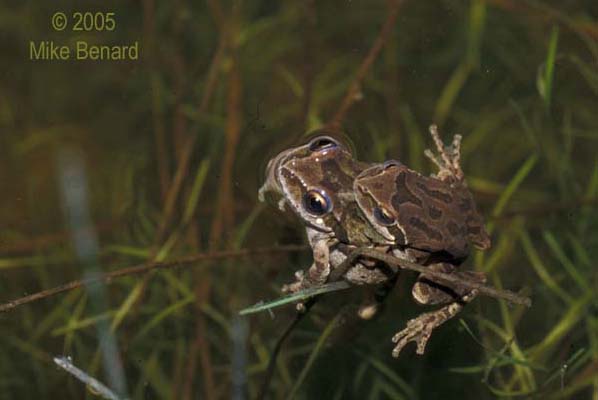
Pseudacris regilla
All text and photographs © Michael F. Benard

|
Natural History of the Pacific Treefrog Pseudacris regilla All text and photographs © Michael F. Benard Indtroduction and Identification
|

|
|
|

A shallow puddle in Napa County, CA, where Pacific treefrogs bred. In February this puddle was full of eggs. However, it dried long before any of the treefrog tadpoles could escape the puddle by metamorphosing. |

An ephemeral pond in Napa County, CA, where Pacific treefrogs breed. This photo was taken in February when the pond was at its deepest. Predators of pacific treefrogs at this pond include predaceous diving beetles, giant water bugs, and garter snakes. |

A permanent pond in Napa County, CA, where Pacific treefrogs breed. This pond contains predatory invertebrates, such as odonate nymphs, as well as large centrachid fish like bluegill sunfish. |
 A mating pair of pacific treefrogs in amplexus. The male is clinging to the back of the female. |
While the male pacific treefrogs call away at the pond, females approach and select males to mate with. Research has shown that female pacific treefrogs prefer to mate with males that consistently call earlier than the other males around them (Whitney and Krebs 1975). Additionally, larger male frogs are more likely to mate with female frogs than smaller males (Benard, in press). During the peak of the breeding season, huge numbers of males will all be out on the same nights. When two males get too close to each other, they will often switch from using "advertisement" calls to "encounter" calls to drive the other males off (Brenowitz and Rose 1999). While the encounter call may drive off the other male, female pacific treefrogs are not attracted to the encounter call. If one does not back down, there may be a physical attack by one frog on another.
When a female approaches a male, the male will move onto her back, and grasp her under her forelimbs with his forelimbs in a position known as "amplexus". The female will now swim into a pond and lay eggs on vegetation, debris and other structures. As the female lays eggs, the male will release sperm to fertilize the eggs. Females will lay multiple egg masses that range in size from one or two eggs to over 100 eggs. |

|

|

|

Metamorphosing pacific treefrog. |

Metamorphosing pacific treefrog. |

Common garter snake (Thamnophis sirtalis), one of the predators that feed on metmorphosing pacific treefrogs. |
|
Conservation Issues
Fill in text |
|
A note about names
Fill in text |
Literature Cited Croes, SA, and RE Thomas. 2000. Freeze tolerance and cryoprotectant synthesis of the pacific treefrog, Hyla regilla. Copeia. 2000:863-868. Blaustein, AR, PD Hoffman, DG Hokit, JM Kiesecker, SC Walls, JB Hays. 1994. UV Repair and resistance to solar UV-B in amphibian eggs: a link to population declines? PNAS. 91:1791-1795. Brenowitz, EA and GJ Rose. 1999. Female choice and plasticity of male calling behaviour in the Pacific treefrog. Animal Behaviour. 57:1337-1342 Fisher, RN, and HB Shaffer. 1996. The decline of amphibians in California�s great central valley. Conservation Biology. 10:1387-1397. Jameson, DL. 1956. Growth, dispersal and survival in the pacific treefrog. Copeia. 1956:25-29. Jameson, DL, JP Mackey, M Anderson. 1973 Weather, climate, and external morphology of pacific tree toads. Evolution 27:285-302. Jameson, DL and S Pequegnat.. 1971. Estimation of relative viability and fecundity of color polymorphisms in anurans. Evolution 25:180�194. Matthews, KR, KL Pope, HK Preisler, RA Knapp. Effects of nonnative trout on Pacific treefrogs (Hyla regilla) in the Sierra Nevada. Copeia 2001:1130-1137. Stebbins, RC 2003. A Field Guide to Western Reptiles and Amphibians. 3rd Edition. Houghton Mifflin Company, 2003. Wente, WH and JB Phillips. 2003. Fixed green and brown color morphs and a novel color-changing morph of the pacific treefrog, Hyla regilla. American Naturalist. 162:461-473. Wente, WH and JB Phillips. 2005a. Microhabitat selection by the Pacific treefrog, Hyla regilla. Animal Behaviour. 70:279-287. Wente, WH and JB Phillips. 2005b. Seasonal color change in a population of pacific treefrogs (Pseudacris regilla). Journal of Herpetology. 39:161-165. | ||||
| Attention All text and photograhs on this website are copyright Michael Benard. If you have any inquiries about using any of this material, or for any other questions, I can be contacted by email at mfbenard 'at' gmail dot com. |
|
|
|
Some interesting outside links:
|